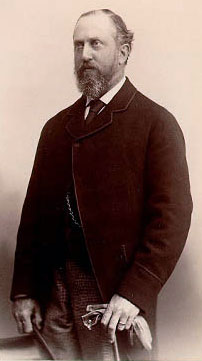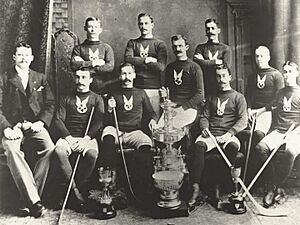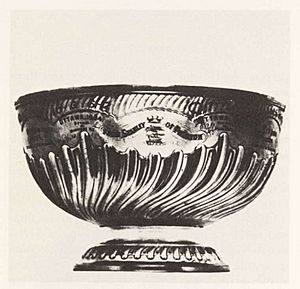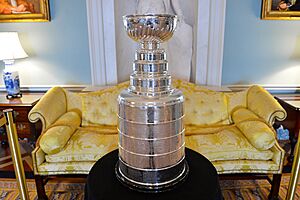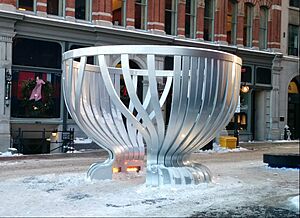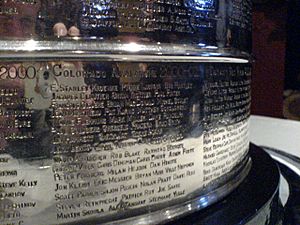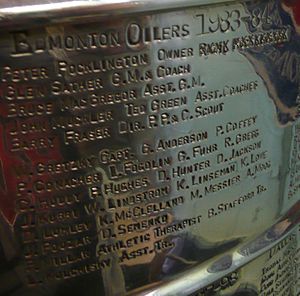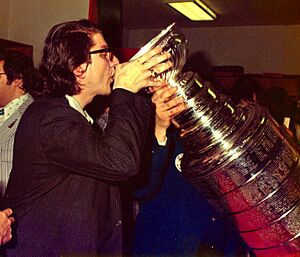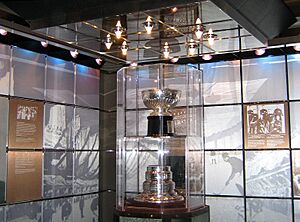Stanley Cup facts for kids
Quick facts for kids Stanley Cup |
|
|---|---|
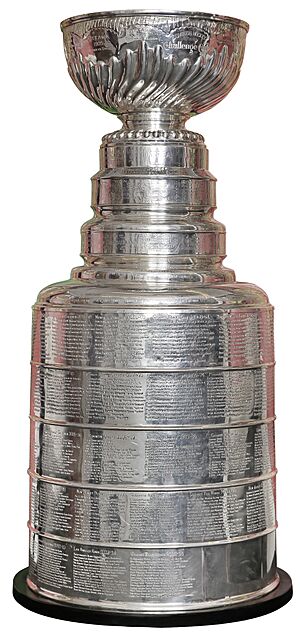 |
|
| Sport | Ice hockey |
| Competition | Stanley Cup playoffs |
| Given for | Playoff champion of the National Hockey League (NHL) |
| History | |
| First award | 1893 |
| First winner | Montreal Hockey Club (4) (AHAC) |
| Most wins | Montreal Canadiens (24) |
| Most recent | Florida Panthers (2) |
The Stanley Cup (French: La Coupe Stanley) is the championship trophy given out every year to the team that wins the National Hockey League (NHL) playoffs. It's the oldest trophy still given to a professional sports team in North America. Many people, including the International Ice Hockey Federation (IIHF), think it's one of the most important championships in hockey.
The trophy was first created in 1892 and was called the Dominion Hockey Challenge Cup. It's named after Lord Stanley of Preston, who was the governor general of Canada. He gave it as a prize for Canada's best amateur ice hockey team. His whole family loved and supported the sport. The first Cup was given out in 1893 to the Montreal Hockey Club. From 1893 to 1914, winners were decided by challenge games and league play. Professional teams could start playing for the Stanley Cup in 1906.
In 1915, the two main professional hockey groups, the National Hockey Association (NHA) and the Pacific Coast Hockey Association (PCHA), agreed that their champions would play each other every year for the Stanley Cup. It became the main championship trophy for the NHL in 1926 and officially the NHL's prize in 1947.
There are actually three Stanley Cups: the original bowl, the "Presentation Cup" which is given to the winners, and the "Permanent Cup" that stays at the Hockey Hall of Fame. The NHL manages the trophy and its name, but they don't actually own it. They use it through an agreement with two Canadian trustees. The NHL has registered trademarks for the Stanley Cup's name and look.
The original bowl was made of silver and was about 18.5 centimeters (7.3 inches) tall. The current Stanley Cup has a copy of the original bowl on top. It's made of a silver and nickel mix. It stands about 89.5 centimeters (35.25 inches) tall and weighs about 15.6 kilograms (34.5 pounds). Unlike trophies in other major sports, a new Stanley Cup isn't made every year. Winners used to keep it until a new champion was crowned. Now, winning teams get to have the Stanley Cup during the summer and for a few days during the season.
Since 1924, names of winning players, coaches, and staff have been carved onto the Cup's bands. This is very unusual for a trophy. However, there isn't enough space for everyone, so some names are left out. Between 1924 and 1940, new bands were added almost every year, making the trophy very tall, like a "Stovepipe Cup." In 1947, the Cup's size was made smaller. In 1958, the modern one-piece Cup was designed with five bands. Each band can hold the names of 13 winning teams.
Every 13 years, when a bottom band is full, it's taken off and put in the Hockey Hall of Fame. The other bands slide up, and a new blank band is added at the bottom. This means a team's name can stay on the trophy for up to 65 years. The Cup is also called The Cup, Lord Stanley's Cup, or The Holy Grail. Many fun stories and traditions are linked to the Stanley Cup, like the winning team drinking champagne from it.
Since the 1914–15 season, 21 current NHL teams and five teams that no longer exist have won the Cup 106 times. It wasn't given out in 1919 because of the Spanish flu epidemic. It also wasn't awarded in 2005 due to an NHL lockout. The Montreal Canadiens have won it a record 24 times. They were the last Canadian team to win it in 1993. The Detroit Red Wings have won it 11 times, the most for any U.S.-based NHL team. They last won in 2008. The current champions are the Florida Panthers, who won in 2024 and 2025. Their 2024 win was their first ever. By 2017, over 3,000 different names, including more than 1,300 players, had been engraved on the Cup.
Contents
The Stanley Cup's Journey Through History
How the Stanley Cup Began
Lord Stanley of Preston became the governor general of Canada in 1888. He and his family quickly fell in love with ice hockey. Lord Stanley first saw the game at Montreal's 1889 Winter Carnival. He watched the Montreal Victorias play the Montreal Hockey Club. Reports said he was "very happy with the game of hockey and how skilled the players were." At that time, organized hockey in Canada was just starting. Only Montreal and Ottawa had anything like leagues.
Lord Stanley's whole family played hockey. His sons, Arthur and Algernon, even started a new team called the Ottawa Rideau Hall Rebels. Arthur also helped create the Ontario Hockey Association (OHA). He also started ice hockey in Great Britain. Arthur and Algernon convinced their father to donate a trophy. They wanted it to be a clear sign of the hockey championship.
In 1892, Lord Stanley sent a message to a celebration for the Ottawa Hockey Club. They had won three championships. He said he thought it would be good to have a challenge cup. This cup would be held each year by the champion hockey team in Canada. He wanted the game to be played fairly under clear rules. He was willing to give a cup to the winning team each year.
Soon after, Stanley bought a decorative bowl from England for about ten guineas (around $48.67 US dollars at the time). He had the words "Dominion Hockey Challenge Cup" carved on one side. "From Stanley of Preston" was carved on the other. People started calling it the "Stanley Cup" as early as May 1, 1893.
Lord Stanley wanted the Cup to go to the best amateur hockey team in Canada. Teams would challenge each other for it. He set five main rules:
- Winners must return the Cup in good condition when asked. This is so it can be given to the next winner.
- Each winning team can pay to have their club name and year carved on a silver ring on the Cup.
- The Cup must always be a challenge cup. No team can own it permanently, even if they win it many times.
- The trustees (people in charge of the Cup) have full power over any issues about the winner.
- If a trustee leaves, the other trustee will choose a new one.
Stanley chose Sheriff John Sweetland and Philip D. Ross as the Cup's trustees. Ross served for 56 years, which is a record. In 1893, Sweetland and Ross gave the trophy to the Montreal Amateur Athletic Association. This was for their team, the Montreal Hockey Club. They were the champions of the Amateur Hockey Association of Canada (AHAC). They had "defeated all comers" that season. The trustees thought the AHAC was the best league. So, Montreal was the best team in Canada. The Ottawa team was unhappy because there were no challenge games. Also, the rules for awarding the Cup weren't clear before the season started.
Because of this, the Cup trustees made more specific rules:
- The Cup is automatically given to the team that wins the previous champion's league. No extra game is needed.
- Teams challenging for the Cup must be from senior hockey groups. They must have won their league championship. Challenges are accepted in the order they are received.
- Challenge games (where the Cup could move to a new league) could be one game, two games with total goals, or a best-of-three series. This was to be fair to both teams. All games had to be on the champion's home ice. Dates and times needed trustee approval.
- Money from ticket sales for challenge games was split equally.
- If teams couldn't agree on a referee, the trustees would pick one. Both teams would share the cost.
- A league could not challenge for the Cup twice in one season.
Lord Stanley never saw a Stanley Cup championship game. He also never presented the Cup himself. He had to return to England in July 1893. His older brother had passed away, and Stanley became the 16th Earl of Derby.
The Challenge Cup Era Begins
During the early years, leagues didn't have formal playoffs. The team that finished first in the regular season won the league title. But in 1894, four teams in the five-team AHAC tied for the championship. The AHAC had no way to break ties. After many talks, it was decided that a three-team tournament would happen in Montreal. The Ottawa team got a bye to the final. On March 17, in the first Stanley Cup playoff game, the Montreal Hockey Club beat the Montreal Victorias 3–2. Five days later, Montreal HC beat the Ottawa Hockey Club 3–1 in the first Stanley Cup Final game.
In 1895, Queen's University was the first official challenger. This was a bit confusing. The Montreal Victorias had won their league title and the Stanley Cup. But the challenge match was between the previous year's champion, Montreal HC, and Queen's University. The trustees decided that if Montreal HC won, the Victorias would still be the Stanley Cup champions. Montreal HC won 5–1, and their rivals were crowned champions. The first time a team successfully challenged for the Cup was the next year. The Winnipeg Victorias, champions of the Manitoba Hockey League, won it. On February 14, 1896, Winnipeg beat the champions 2–0. They became the first team outside the AHAC to win the Cup.
As the Cup became more famous, teams wanted to attract the best players. In March 1906, the Montreal Wanderers decided to allow professional players to play with amateurs. The Cup trustees agreed to let professional teams challenge for the Cup. This was because the Eastern Canada Amateur Hockey Association (ECAHA) was the top league in Canada then. The first professional competition happened a month later. The Wanderers won their two-game series by a total of 17 goals to 5.
The smallest town to have a Stanley Cup champion team is Kenora, Ontario. The town had about 4,000 people when the Kenora Thistles won the Cup in January 1907. The Thistles, led by future Hall of Famers Art Ross and "Bad" Joe Hall, beat the Montreal Wanderers. The Thistles defended the Cup once against a team from Brandon, Manitoba. But in March 1907, the Wanderers challenged them again and won the Cup back.
In 1908, the Allan Cup was created for amateur teams. The Stanley Cup then became a symbol of professional hockey. That same year, the first all-professional team, the Toronto Trolley Leaguers, played for the Cup. In 1910, the National Hockey Association (NHA) was formed. The NHA quickly proved to be the best in Canada. They held the Cup for the next four years. Before 1912, challenges could happen anytime. Teams often defended the Cup many times a year. In 1912, the Cup trustees said it could only be defended at the end of the champion team's regular season.
Organized League Competitions
In 1914, the Victoria Aristocrats from the Pacific Coast Hockey Association (PCHA) challenged the NHA and Cup champion Toronto Blueshirts. There was a problem when the Stanley Cup trustees said they wouldn't let the Cup travel west. They didn't think Victoria was a proper challenger. But the next day, a trustee said it was a misunderstanding. The PCHA president hadn't formally challenged because he expected the NHA to handle it. All issues were sorted out, and Victoria's challenge was accepted.
Later, the trustees agreed to let the three professional leagues (NHA, PCHA, and Maritime) arrange the Cup matches each season. A year later, the Maritime league closed. The NHA and PCHA then agreed that their champions would play each other for the Cup. This was like baseball's World Series. The Stanley Cup Final series would switch between East and West each year. Games would use NHA and PCHA rules alternately. The PCHA's Vancouver Millionaires won the 1915 series three games to none.
Before hockey grew much outside Canada, the Stanley Cup champion was already called the "world champion." When the Portland Rosebuds, an American team, joined the PCHA in 1914, the trustees said the Cup was now for the best team in the world. Hockey in Europe was new then, so it wasn't a big deal for winners to call themselves "world champions." Two years later, the Rosebuds became the first American team to play in the Stanley Cup Final. In 1917, the Seattle Metropolitans became the first American team to win the Cup. After that season, the NHA was replaced by the National Hockey League (NHL).
The Spanish flu epidemic caused the 1919 Stanley Cup Final to be canceled. The Montreal Canadiens and Seattle Metropolitans were tied 2–2–1. The final game was never played because several Montreal players and their manager were sick with the flu. One player, Joe Hall, died four days later. This was the first time the Stanley Cup was not awarded.
The Stanley Cup Final format changed in 1922. The Western Canada Hockey League (WCHL) was created. Three leagues played for the Cup: two league champions played each other, and the winner challenged the third champion. This lasted three seasons. The PCHA and WCHL then joined to form the Western Hockey League (WHL) in 1925. In 1924–25, the Victoria Cougars won the Cup. They were the last team outside the NHL to do so.
The NHL Takes Over the Cup
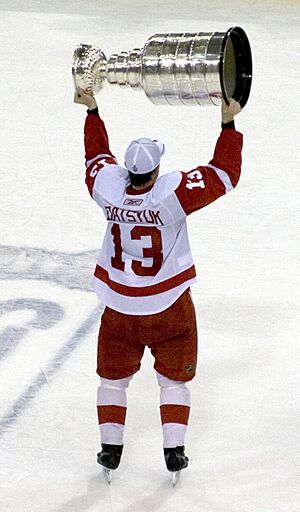
The WHL stopped operating in 1926. The NHL bought most of the WHL's players. They used them to fill the rosters of three new U.S. teams: the Chicago Blackhawks, Detroit Cougars (now Detroit Red Wings), and New York Rangers. The NHL was now strong in major U.S. cities. The Western teams had lost their best players. So, other leagues were seen as "minor leagues" and not worthy of challenging the NHL for hockey's top prize.
Other leagues tried to challenge for the Cup over the next two decades, but none were accepted. Since 1926, no non-NHL team has played for the Cup. This made it the main championship trophy of the NHL. The NHL also started calling its champions "world champions."
In 1947, the NHL made an agreement with trustee Cooper Smeaton. This gave the NHL control over the Cup. It allowed the league to say no to challenges from other leagues. The agreement said the winners would be the "acknowledged World's Professional Hockey Champions." The NHL also promised to take care of the Cup.
This agreement was updated in 1961. In the 1970s, the World Hockey Association (WHA) wanted to challenge for the Cup. But the Cup trustees were loyal to the NHL. The NHL president, Clarence Campbell, blocked the WHA's challenge. However, the NHL quietly stopped calling its champions "world champions." This was because of the WHA and the growing skill of European hockey leagues.
The NHL faced pressure to let its champion play the WHA champion. Eventually, the Canada Cup was created as the first "best-on-best" international hockey tournament. NHL president Clarence Campbell then suggested a true world professional championship. The NHL champion would play the WHA champion, and that winner would face the European champion. This idea didn't go anywhere. The NHL later solved the WHA challenge by merging with it. Neither the NHL nor any other professional hockey league now claims its champions are "world champions."
The Cup was awarded every year until 2005. A labor dispute between the NHL's owners and players led to the cancellation of the 2004–05 season. So, no Cup champion was named for the first time since the flu pandemic in 1919. Many fans wondered if the NHL had full control over the Cup. Some wanted the Cup to go back to its original challenge format. Adrienne Clarkson, then governor general of Canada, suggested giving the Cup to the top women's hockey team. This idea was not popular, so the Clarkson Cup was created instead. A group in Ontario even went to court. They said the trustees had gone too far by signing the 1947 agreement. They argued the trophy should be awarded no matter what.
On February 7, 2006, an agreement was reached. It said the trophy could be given to non-NHL teams if the league didn't play for a season. The dispute lasted so long that the NHL had already started its 2005–06 season. So, the Stanley Cup remained unclaimed for the 2004–05 season. When another NHL lockout happened in 2012, the trustees said the 2006 agreement didn't force them to award the Cup if a season was lost. They would likely reject any non-NHL challenges. The 2012–13 season was not canceled.
In 2007, the International Ice Hockey Federation (IIHF) officially recognized the "Triple Gold Club." This group includes players and coaches who have won an Olympic Games gold medal, a World Championship gold medal, and the Stanley Cup.
Celebrating 125 Years of the Cup
In March 2017, to celebrate the Stanley Cup's 125th anniversary, the original Cup and the current Stanley Cup went on a four-day tour in Ottawa. This included a stop at Rideau Hall. The Royal Canadian Mint made two special coins for the anniversary. One was a roll of Canadian quarters with the Stanley Cup, hockey players, and "125 years" on it. The other was a silver coin with the Cup and "50 dollars" on it.
In October 2017, the Lord Stanley's Gift Monument was built in Ottawa. It's near where the dinner party announcing the Cup happened. This monument celebrates Lord Stanley's gift of the Cup.
Engraving Names on the Cup
Like the Grey Cup in Canadian football, the Stanley Cup has the names of winning players, coaches, and staff carved on it. But this wasn't always the rule. Lord Stanley's original rules said each team could pay to add a ring to the Cup to remember their win. At first, there was only one base ring. Teams carved their names on it until it was full in 1902. With no more space, teams started carving names on the bowl itself. The 1907 Montreal Wanderers were the first to carve the names of 20 team members inside the bowl.
In 1908, the Wanderers didn't carve their names. The next year, the Ottawa Senators added a second band. But the 1910 Wanderers and 1911 Senators still didn't put their names on the Cup. The 1915 Vancouver Millionaires were the second team to carve players' names, this time inside the bowl.
The 1918 Millionaires eventually filled the band added by the 1909 Senators. Some teams, like the 1915 Ottawa Senators, 1916 Portland Rosebuds, and 1918 Vancouver Millionaires, carved their names even if they didn't officially win under the new PCHA-NHA system. They had won their league title and would have been Cup champions under the old challenge rules. The winners from 1918 and 1920 to 1923 didn't put their team name on it.
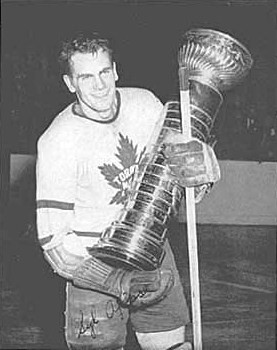
No more names were carved until 1924, when the Canadiens added a new band. Since then, carving the team and player names has been a yearly tradition. At first, a new band was added every year, making the trophy grow very tall. It was called the "Stovepipe Cup." It became too hard to handle. So, in 1948, it was redesigned as a two-piece trophy with a removable bowl and collar. This new Cup also honored teams that hadn't carved their names before. It also noted the 1918–19 season that was canceled.

Since 1958, the Cup has had small changes. The original collar and bowl were too weak and were replaced in 1963 and 1969. The modern one-piece Cup design started in 1958. The old barrel was replaced with a new one that has five bands. Each band can hold 13 winning teams. The bands were supposed to be full by 1992, the Cup's 100th year. But the 1965 Montreal Canadiens' names were carved over a larger area. So, that band has only 12 teams instead of 13. When all the bands were full in 1991, the top band was moved to the Hockey Hall of Fame. A new blank band was added to the bottom so the Cup wouldn't get any taller.
Another new band was supposed to be added after the 2004–05 season. But it wasn't because of the 2004–05 NHL lockout. After the 2005–06 Carolina Hurricanes won, the new bottom ring was finally added. The band with champions from 1940–41 to 1952–53 was retired. The canceled season was noted with the words "2004–05 season not played."
After the 2017–18 Washington Capitals won, the band with winners from 1953–54 to 1964–65 was removed in September 2018. A new band for the 2017–18 to 2029–30 champions was added to the bottom. Since the five-band cup was introduced, each team's name stays on the trophy for 52 to 65 years.
Only four official Stanley Cup engravers have existed. The current one, Louise St. Jacques from Montreal, has been doing it since 1988.
Today, the Cup is 89.5 centimeters (35.25 inches) tall and weighs 15.6 kilograms (34.5 pounds). By its 125th anniversary in 2017, 3,177 names had been carved on it. Of those, 1,331 belong to players.
Who Gets Their Name on the Cup?
To automatically get their name carved on the Cup, a player must:
- Have played, or been the backup goalie, for at least half of the championship team's regular season games, OR:
- Have played, or been the backup goalie, for at least one game of the Stanley Cup Final for the championship team, AND:
- Be on the team's roster when they win the Stanley Cup.
However, since 1994, teams can ask the NHL Commissioner to add a player's name if they couldn't play due to special reasons. For example, the Detroit Red Wings got permission to carve Vladimir Konstantinov's name in 1998. His career ended after a car accident in 1997.
The Montreal Canadiens have won the most Cups. So, many players with the most engravings are from Montreal. Henri Richard of the Canadiens has his name carved eleven times. This is more than any other player. He is followed by Jean Beliveau and Yvan Cournoyer (Canadiens) with ten championships. Claude Provost (Canadiens) has nine. Three players have eight: Red Kelly (four with Red Wings, four with Leafs – the most for a non-Canadien) and Canadiens players Jacques Lemaire and Maurice Richard. Jean Beliveau's name appears on the Cup more than anyone else. He was on it ten times as a player and seven times as management, for a total of seventeen times.
Twenty women have had their names carved on the Stanley Cup. The first was Marguerite Norris. She won as the president of the Detroit Red Wings in 1954 and 1955. The only Canadian woman to have her name carved is Sonia Scurfield. She won as a co-owner of the Calgary Flames in 1989.
In 2001, Charlotte Grahame, a director for the Colorado Avalanche, had her name carved. Her son John later had his name carved as a member of the Tampa Bay Lightning in 2004.
Mistakes and Changes on the Cup
There are some misspelled names on the Cup. Many have never been fixed. For example:
- Pat McReavy's name is misspelled "McCeavy" for the 1941 Boston Bruins.
- Dickie Moore won the Cup six times, but his name was spelled differently five times.
- Jacques Plante won five times in a row, and his name was spelled differently each time.
- Glenn Hall's name was misspelled as "Glin" in 1951–52.
- Alex Delvecchio's name was misspelled as "Belvecchio" in 1954.
- Bob Gainey was spelled "Gainy" in the 1970s.
- Toronto Maple Leafs was spelled "Leaes" in 1963.
- Boston Bruins was spelled "BQSTQN" in 1972.
- New York Islanders was spelled "Ilanders" in 1981.
- In 1996, Adam Deadmarsh's name was misspelled as "Deadmarch." It was later fixed. This was the first correction on the Cup. Other corrections were made for Manny Legace (2002), Eric Staal (2006), and Kris Versteeg (2010).
- Justin Williams's name was spelled "JUSTIN WILLIVIS" in 2014. This has since been corrected.
- Patrick Maroon had his name spelled differently: "Patrick Maroon" in 2019 and "Pat Maroon" in 2020.
Names Removed from the Cup
Some names have been scratched out with "X"s:
- Peter Pocklington, then-owner of the Edmonton Oilers, put his father's name, Basil, on the Cup in 1984. Basil had no connection to the Oilers or NHL. So, the league had his name removed.
- Brad Aldrich, a video coach for the Chicago Blackhawks in 2010, had his name removed in 2021. This was after an investigation showed he had abused a former player.
Fun Traditions and Stories of the Cup
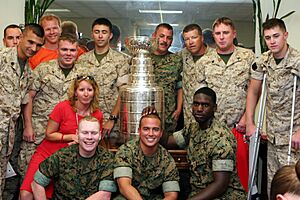
Many traditions are linked to the Stanley Cup. One of the oldest started in 1896. The winning team, the Winnipeg Victorias, drank champagne from the top bowl after their win. The Cup is also usually given on the ice by the NHL commissioner to the winning team's captain. Each team member then carries the trophy around the rink. This wasn't always the case. Before the 1930s, the Cup wasn't given right after the win. The first time it might have been given on the ice was to the 1932 Toronto Maple Leafs. But it became a tradition in the 1950s. Ted Lindsay of the 1950 Detroit Red Wings was the first captain to lift it overhead and skate around. He said he did it so fans could see the Cup better. Since then, it's a tradition for each winning team member to take a lap with the trophy above their head.
The tradition of the captain lifting the Cup first has been broken a few times. In 1987, after the Edmonton Oilers won, Wayne Gretzky gave the Cup to Steve Smith. This was a year after Smith made a big mistake that cost the Oilers a chance at the Final. In 1993, after the Montreal Canadiens won, Guy Carbonneau gave the Cup to Denis Savard. Many fans had wanted the Canadiens to draft Savard in 1980. The third time was in 2001 with Joe Sakic and Ray Bourque. The Colorado Avalanche won, and it was the last game of Bourque's 22-year career. He had never won a Cup before. When Sakic got the trophy, he immediately gave it to Bourque. Sakic then became the second player to lift it.
The Stanley Cup champion team gets 100 days in the off-season to share the Cup. It's always with at least one person from the Hockey Hall of Fame. Many players have unofficially had the Cup for a day. In 1995, the New Jersey Devils started a tradition where each team member gets the Cup for a day. After the 1994–95 season, the NHL made it a rule that an official Cup handler must always be present when players have the Cup in the off-season. This might be because Eddie Olczyk brought the Cup to a horse race in 1994. The horse, Go for Gin, even ate out of it!
On August 22, 2001, Mark Waggoner, a director for the Colorado Avalanche, took the Stanley Cup to the top of Mount Elbert. This is the highest point in Colorado.
Winners have used the Cup to baptize their children. Three players even let their dogs eat out of the Cup.
The Different Stanley Cups
There are three versions of the Stanley Cup:
- The original 1892 bowl, called the Dominion Hockey Challenge Cup. This was given to champions until 1970. It's now in the Vault Room at the Hockey Hall of Fame in Toronto, Ontario.
- The "Presentation Cup." This was made in 1963 by Carl Petersen, a silversmith from Montreal. The NHL president felt the original bowl was getting too fragile. So, he asked for a copy. The Presentation Cup has a Hockey Hall of Fame seal on the bottom. This is the one given to the playoff champions and used for public events. It was made in secret and first given out in 1964.
- The "Permanent Cup." This copy was made in 1993 by Louise St. Jacques. It's used at the Hockey Hall of Fame when the Presentation Cup is not there. It's also a backup in case the Presentation Cup is lost or damaged.
The Cup as a Morale Booster
The Stanley Cup has been brought to military bases for American, Canadian, and NATO troops. In 2004, the Cup was shown at MacDill Air Force Base in Florida. Officials there said it was "a huge morale booster for our troops." In 2006, the Cup visited Marine Corps Base Camp Lejeune in North Carolina. Wounded Marines could see and take photos with the Cup.
In 2007, the Stanley Cup went to a combat zone for the first time. It was in Kandahar, Afghanistan, from May 2 to 6. The NHL, Hockey Hall of Fame, and Canadian military organized the trip. The Cup was shown to Canadian and other NATO troops. The Cup was not harmed when the base was attacked by rockets on May 3.
The Stanley Cup went back to Afghanistan in March 2008 as part of a "Team Canada visit." In spring 2010, the Stanley Cup made its fourth trip to Afghanistan with former players.
On June 27, 2010, Chicago Blackhawks player Brent Sopel honored his friend, Brian Burke, and Burke's late son, Brendan. He brought the Cup to the 2010 Chicago Gay Pride Parade.
In 2018, the Cup was used to cheer up people affected by two sad events. These were the Humboldt Broncos bus crash on April 6 and the Capital Gazette shooting on June 28. For the Broncos, the Cup was brought to the hospital where survivors were recovering on April 15. For the Capital Gazette, it was shown to employees at their temporary office on July 3. Chandler Stephenson of the 2018 Washington Capitals also spent his day with the Stanley Cup with the Broncos that August.
The Cup's Trustees
Lord Stanley's rules said there should be two trustees. They had the only power to manage the Cup and how it was awarded. This lasted until 1947, when they gave control to the NHL. The original rules allow a trustee to resign. So far, only Ian "Scotty" Morrison retired as trustee in 2023. All other trustees served until they passed away. If a trustee leaves, the remaining trustee chooses a replacement.
So far, eleven men have served as trustees of the Stanley Cup:
| Trustee | Year of Appointment | Served Until | Succeeded |
|---|---|---|---|
| Sheriff John Sweetland | 1893 | 1907 | N/A |
| P. D. Ross | 1893 | 1949 | N/A |
| William Foran | 1907 | 1945 | Sweetland |
| Cooper Smeaton | 1946 | 1978 | Foran |
| Mervyn "Red" Dutton | 1950 | 1987 | Ross |
| Clarence Campbell | 1979 | 1984 | Smeaton |
| Justice Willard Estey | 1984 | 2002 | Campbell |
| Brian O'Neill | 1987 | 2023 | Dutton |
| Ian "Scotty" Morrison | 2002 | 2023 | Estey |
| Lanny McDonald | 2023 | current | O'Neill |
| Gary Meagher | 2023 | current | Morrison |
More About Hockey Trophies
- Avco World Trophy, given to the champion of the old World Hockey Association
- List of awards named after governors general of Canada
- List of awards presented by the governor general of Canada
- List of NHL franchise post-season appearance streaks
- List of NHL franchise post-season droughts
- List of Stanley Cup challenge games
- List of Stanley Cup champions
- Lord Derby Cup, a rugby league trophy in France, named after Frederick Stanley's son Edward
See also
 In Spanish: Copa Stanley para niños
In Spanish: Copa Stanley para niños


